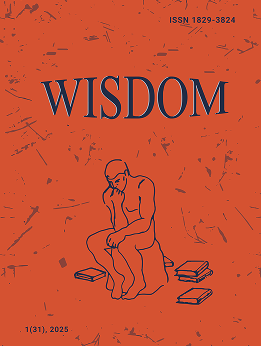The Philosophy of Education and Upbringing as the Quintessence of Women's Emancipation
DOI:
https://doi.org/10.24234/wisdom.v4i3.922Keywords:
philosophy of education, quintessence, Constantinople, women’s education and upbringing, charitable schools and collegesAbstract
The paper focuses on the philosophical and socio-historical subtexts of the ideas on education and upbringing in Constantinople in the late 19th century and early 20th centuries, with examples from the works of Armenian female authors: Elpis Kesaratsian, Srbuhi Tyusab, Sipil, Haykanush Mark, Zapel Yesayan. According to them, the main historical and philosophical prerequisites for changing attitudes towards women’s education and upbringing relate not only to women but also to men. The aim of the paper is to study the issues of women’s indisputable right to education and upbringing, their natural learning abilities and opportunities as the quintessence of emancipation formed in Constantinople. The problem of the study is to show the philosophical subtext of the establishment of institutions for women’s education and upbringing, the organization of education, as well as the processes of overcoming the patriarchal tradition through education. This kind of study has been attempted for the first time. Since the 50s-60s of the 19th century, not only the nature of work and status of women but also the issues of their education and upbringing had special significance in Constantinople.
Downloads
References
Azgayin sahmanadrutíiun Hayoc (National Constitution of Armenia, in Armenian). (1863). Constantinople: Y. Myuhntesian Publishing House.
Hambardzumyan, N. (2021). K.Polsi hayoc baregorcakan ynkerutyunneri yev varzharanneri derakatarutyuny kananc azatagrutyan gorcyntacnerum 19-rd dari yerkrord kesin (The role of Armenian charities and colleges in the process of womenís emancipation in the second half of the 19th century in Constantinople, in Armenian). Gitakan Artsakh (Scientific Artsakh, in Armenian), 4(11), 35-43. DOI: https://doi.org/10.52063/25792652-2021.4-35
Hambardzumyan, N. (2022a). Existential-ontological manifestations of time in Khrimian Hayrikís essay ìTime and Itís Essenceî. WISDOM, Special Issue (Philosophy of Language and Literature). 3(2), 48-54. https://doi.org/10.24234/wisdom.v3i2.854 DOI: https://doi.org/10.24234/wisdom.v3i2.854
Hambardzumyan, N. (2022b). K. Polsi hayoc baregorcakan yev parzasirac ynkerutyunneri yev miutyunneri derakatarutyuny kananc azatagrutyan gorcyntacnerum 19-rd dari yerkrord kesin (The role of Armenian charities and plain-loving societies and unions in the process of womenís emancipation in the second half of the 19th century in Constantinople, in Armenian). Gitakan Artsakh (Scientific Artsakh, in Armenian), 1(44), 61-70. DOI: https://doi.org/10.52063/25792652-2021.4-35
Kesaratsian, E. (1862a, August 1). Arajaban (Introduction, in Armenian). Kitar (Guitar: Monthly magazine, in Armenian), 1, 1-2. Constantinople: Kurkjian. https://tert.nla.am/archive/NLA %20AM SAGIR/Kitar-1862/1862/1862(1).pdf
Kesaratsian, E. (1862b) Dastiarakutíiun oriordac (Upbringing of maidens, in Armenian). Kitar (Guitar: Monthly magazine, in Armenian), 2, 12-14; 3, 22-24; 4, 27-30; 5, 35-38. Constantinople: Kurkjian.
Kesaratsian, E. (1862c, August 1). Iravunqn i gorc dneln yandgnutyun che (Exercising the Right is not Audacity, in Armenian). Kitar (Guitar: Monthly magazine, in Armenian), 1, 7-8. Constantinople: Kurkjian. https://tert.nla.am/archive/NLA%20AMSAGIR/Kitar-1862/1862/1862(1).pdf
Kesaratsian, E. (1879). Namakani ar yntercaser hayuhis (Collection of letters to a reading armenian woman, in Armenian). Constantinople: Paronian Publishing House.
Kharatyan, A. (1989). Arevmtahay parberakan mamuly yev graqnnutyuny osmanian Turqiayum (1857-1908) (The Western Armenian periodical press and censorship in Ottoman Turkey (1857-1908), in Armenian). NAS RA. Yerevan: NAS RA Publishing house.
Poghosian, E. (1953). Patmutíiun hay mshakutayin ynkerutyunneru (History of Armenian Cultural Associations, in Armenian) (Vol. 1). Vienna: Mkhitaryan publishing House.
Raffi (1991). Yerkeri Joghovatsu 12 hatorov (Collected works in 12 vols, in Armenian) (Vol. 11). Yerevan: ìNairiî.
Sipil (1891). Aghjkan myí sirty (A girlís heart, in Armenian). Constantinople: Tchivelekean publishing house.
Theodik (1911). Amenun Taretsoyts (Everyoneís Yearbook, in Armenian). Costantinople: Nersesian Publishing House.
Trevelyan, G. (2013). English Social History: A Survey of Six Centuries: Chaucer to Queen Victoria, London, UK: Longmans Green.
Tyusab, S. (1884). Siranush (Siranush, in Armenian). Constantinople: Nshan K Perperean publishing house.
Tyusab, S. (1925). Araksia kam Varzhuhin (Araksia or the Governess, in Armenian). Constantinople: Arev publishing house.
Tyusab, S. (1981). Yerker: Mayta (Compositions: Mayta, in Armenian). Yerevan: Sovetakan Grogh publishing house.
Voskanian, S. (1864). Kitar anun hands (The magazine named Guitar, in Armenian). Arevmutk (West, in Armenian), 2, 9-13. Paris: Araks.
Yesayan, Z. (1977). Namakner (Letters, in Armenian). Yerevan: YSU Publishing House.
Yesayan, Z. (2018). Silihtari partezner (Gardens of Silihtar, in Armenian). Yerevan: Antares.
Utudjian, K. (1867). Khmbagrakan (Editorial, in Armenian). Masis, 811, 3.
Downloads
Published
How to Cite
Issue
Section
License
Copyright (c) 2022 Naira HAMBARDZUMYAN, Siranush PARSADANYAN

This work is licensed under a Creative Commons Attribution-NonCommercial 4.0 International License.
Creative Commons Attribution-Non-Commercial (CC BY-NC). CC BY-NC allows users to copy and distribute the article, provided this is not done for commercial purposes. The users may adapt – remix, transform, and build upon the material giving appropriate credit, and providing a link to the license. The full details of the license are available at https://creativecommons.org/licenses/by-nc/4.0/.















